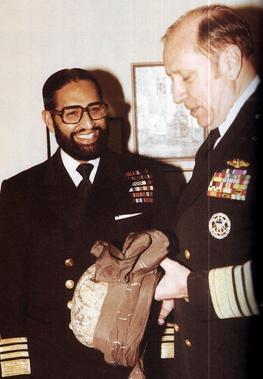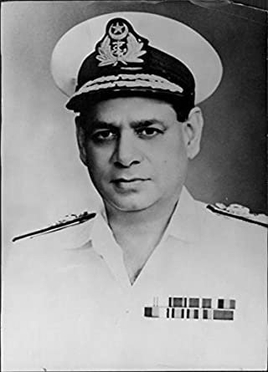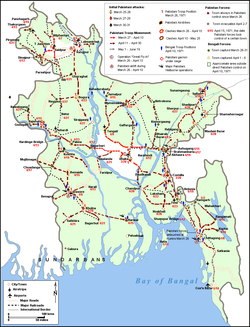
East Pakistan was the eastern polity, established in 1955 under the One Unit Policy, renaming and restructuring the province as such from East Bengal, which, in modern times, is split between India and Bangladesh. Its land borders were with India and Burma, with a coastline on the Bay of Bengal. East Pakistanis were popularly known as "Pakistani Bengalis"; to distinguish this region from India's state West Bengal, East Pakistan was known as "Pakistani Bengal". In 1971, East Pakistan became the newly independent state Bangladesh, which means "country of Bengal" or "country of Bengalis" in Bengali language.

The Indo-Pakistani War of 1971 was a military confrontation between India and Pakistan that occurred during the Bangladesh Liberation War in East Pakistan from 3 December 1971 until the Pakistani capitulation in Dhaka on 16 December 1971. The war began with Pakistan's Operation Chengiz Khan, consisting of preemptive aerial strikes on 11 Indian air stations. The strikes led to India declaring war on Pakistan, marking their entry into the war for East Pakistan's independence, on the side of Bengali nationalist forces. India's entry expanded the existing conflict with Indian and Pakistani forces engaging on both the eastern and western fronts. Thirteen days after the war started, India achieved a clear upper hand, and the Eastern Command of the Pakistan military signed the instrument of surrender on 16 December 1971 in Dhaka, marking the formation of East Pakistan as the new nation of Bangladesh. Approximately 93,000 Pakistani servicemen were taken prisoner by the Indian Army, which included 79,676 to 81,000 uniformed personnel of the Pakistan Armed Forces, including some Bengali soldiers who had remained loyal to Pakistan. The remaining 10,324 to 12,500 prisoners were civilians, either family members of the military personnel or collaborators (Razakars).

Lieutenant General Amir Abdullah Khan Niazi was a Pakistan Army officer. During the Bangladesh Liberation War and the Indo-Pakistani War of 1971, he commanded the Pakistani Eastern Command in East Pakistan, he signed the instrument of surrender as in 16 Dec. '71 his forces had to surrender to the Indian Army's Eastern Command's commander Lieutenant General Jagjit Singh Aurora by the order of the then President of Pakistan Yahya Khan.
East Pakistan Air Operations covers the activity of the Pakistan Air Force (PAF) and Pakistan Army Aviation units in former East Pakistan during the Bangladesh Liberation War. The operations involved the interdiction, air defense, ground support, and logistics missions flown by the Bangladesh Air Force, Indian Air Force, and the Indian Navy Aviation wing in support of the Mukti Bahini and later Indian Army in Bengal.
Vice-Admiral Ahmad TasnimHI(M) SJ & Bar SI(M) SBt is a retired three-star rank admiral in the Pakistan Navy who is notable for his command of the Hangor, a submarine, that sank the INS Khukri on 8 December 1971 during the third war with India, off the Diu, Gujarat in India.
Operation Chengiz Khan was the code name assigned to the preemptive strikes carried out by the Pakistani Air Force (PAF) on the forward airbases and radar installations of the Indian Air Force (IAF) on the evening of 3 December 1971, and marked the formal initiation of hostilities of the Indo-Pakistani War of 1971. The operation targeted 11 of India's airfields and also included artillery strikes on Indian positions in Kashmir. The targets were the Indian Airbases of Amritsar, Ambala, Agra, Awantipur, Bikaner, Halwara, Jodhpur, Jaisalmer, Pathankot, Bhuj, Srinagar and Uttarlai and air defence radars at Amritsar and Faridkot.
Sitara-e-Jurat is the third highest military award of Pakistan. It was established in 1957 after Pakistan became a republic; however, it was instituted retrospectively back to 1947. It is awarded for gallantry or distinguished service in combat; and can be bestowed upon officers, junior commissioned officers, petty officers, warrant officers, soldiers, sailors, airmen, and equivalents in the Pakistan Army, Navy, Air Force, and various paramilitary forces under federal control, such as the Frontier Corps, the Frontier Constabulary, and the Pakistan Rangers. It may be considered to be roughly equivalent to the Military Cross and the Silver Star.

Lieutenant General Jagjit Singh Aurora, was an Indian Army General Officer who was the General Officer Commanding-in-Chief (GOC-in-C) Eastern Command during the third war with Pakistan in 1971. He organised and led the ground forces campaign in the Eastern Front of the war, which led to an overwhelming defeat of the combined Pakistan Armed Forces in East-Pakistan that led to the creation of Bangladesh.

Admiral Mohammad ShariffNI(M) HJ HI(M) LoM, was a Pakistan Navy senior admiral, who served as the 2nd Chairman of Joint Chiefs of Staff Committee and a memoirist who was at the center of all the major decisions made in Pakistan in the events involving the war with India in 1971, the enforcement of martial law in the country in 1977, and the decision in covertly intervening against Soviet Union in Afghanistan.

Vice Admiral Muzzafar HassanSPk, HQA, Sk, was a Pakistan Navy senior admiral who served as the last Commander-in-Chief of Pakistan Navy from 1969 until 1972, serving under first President Yahya Khan and then under President Zulfikar Ali Bhutto.

Air Commodore Muhammad Zafar Masud also known as Mitty Masud, was a one star air officer in the Pakistan Air Force and a military strategist who was known for his role as air officer commanding of the Dacca airbase in East Pakistan.
The missing 54 are 54 soldiers and officers of the Indian Armed Forces who went missing in action during the Indo-Pakistani War of 1971 and whom the Indian government believes to be secretly held by Pakistan. Pakistan denies the existence of such prisoners of war.
The Indo-Pakistani Naval War of 1971 refers to the maritime military engagements between the Indian Navy and the Pakistan Navy during the Indo-Pakistani War of 1971. The series of naval operations began with the Indian Navy's exertion of pressure on Pakistan from the Indian Ocean, while the Indian Army and Indian Air Force moved in to choke Pakistani forces operating in East Pakistan on land. Indian naval operations comprised naval interdiction, air defence, ground support, and logistics missions.

Air Marshal Inamul Haque KhanHJ HI(M) SI(M) was a three-star air officer in the Pakistan Air Force who is known for his role as AOC of the Dacca airbase of the Pakistan Air Force.
Vice-Admiral Iqbal Fazl QuadirHI(M), TI(M), SBt, TQA, was a three-star rank admiral in the Pakistan Navy, diplomat and a defence analyst. He was renowned for his participation in Pakistan's second war with India when he was part of the flotilla that attacked the radar station in Dwarka, India.
Rear-Admiral Rashid Ahmed was a two-star rank admiral in the Pakistan Navy, who is known for serving as Chief of Staff under Commander in Chief Vice-Admiral Muzaffar Hassan and led the Navy during the fateful events in the war with India in 1971.
Vice-Admiral Taj Muhammad Khattak, HI(M). SI(M), SJ, is a retired three-star rank admiral in the Pakistan Navy and a defence analyst, writing columns in the political correspondent, News International.
Vice-Admiral Shamoon Alam KhanHI(m), SJ, is a retired three-star rank admiral in the Pakistan Navy and a diplomat.
Abaidullah Khan, known as A. U. Khan, HI(m), SBt, SJ, was a three-star rank admiral in the Pakistan Navy, and later a bureaucrat who played a crucial role in procuring and technology transfer of the air-independent propulsion-based Agosta 90Bravo class submarine from France in 1994–1997.

Group Captain Virendera Singh Pathania was an Indian Air Force (IAF) fighter pilot reputed for making the first confirmed aerial dogfight kill of independent India when he shot down a Pakistan Air Force (PAF) Sabre Jet with his Folland Gnat on 4 September, 1965. For this action, he was awarded the Vir Chakra.









